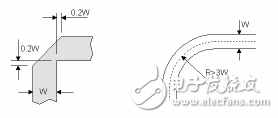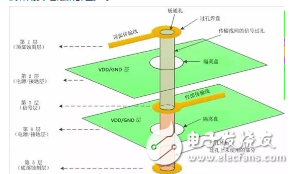Everyone is aware that impedance should be continuous, but as Luo Yonghao once said, "There are always times when you step on the stool." In PCB design, achieving perfect impedance continuity can be challenging. So, how do we handle these situations?
Characteristic impedance, also known as "characteristic impedance," is not a DC resistance but rather a concept from long-line transmission theory. At high frequencies, during signal transmission, an instantaneous current is generated between the signal line and the reference plane (such as a power or ground plane) due to the electric field formation. If the transmission line is uniform, the signal will encounter a constant current I, and with a voltage V, the transmission line behaves like a resistor of value V/I. This resistance is called the characteristic impedance Z of the transmission line. Any change in this impedance along the path can cause signal reflections at the point of discontinuity. Several factors influence characteristic impedance, including dielectric constant, dielectric thickness, trace width, and copper thickness.
[1] Gradient Line
Some RF components come in small packages, where SMD pad widths can be as narrow as 12 mils, while RF signal lines may need to be wider than 50 mils. To avoid abrupt changes in line width, a gradient line is used. The transition section should not be too long, as shown in the figure below.

[2] Corner
If an RF signal line makes a right-angle turn, the effective width at the corner increases, causing impedance discontinuity and signal reflection. To minimize this, two common techniques are chamfering and rounding the corner. The radius of the arc should be large enough—typically R > 3W. As shown in the diagram.
[3] Large Pad
When a large pad is present on a 50-ohm microstrip line, it acts as distributed capacitance, disrupting the characteristic impedance. Two solutions can be applied simultaneously: increasing the thickness of the microstrip medium and hollowing out the ground plane beneath the pad to reduce its parasitic capacitance, as illustrated below.
[4] Via
A via is a metal-plated cylinder connecting different layers of the board. Signal vias link transmission lines across layers. The unused portion of the via is called a via stub, while the via pads are ring-shaped structures connecting the via to the top or internal layers. An isolation disk is an annular gap in each power or ground plane to prevent short circuits.

Parasitic Parameters of Vias
After rigorous physical derivation and approximation analysis, the equivalent circuit model of a via includes a series of grounding capacitors at both ends of an inductor, as shown in Figure 1.
Passive Circuit Model
From the equivalent circuit model, a via has parasitic capacitance to ground. Assuming the via reverse pad diameter is D2, the via pad diameter is D1, the PCB board thickness is T, and the dielectric constant of the substrate is ε, the parasitic capacitance of the via can be approximated as:
This parasitic capacitance can increase the signal rise time and slow down transmission, degrading signal quality. Similarly, vias also have parasitic inductance. In high-speed digital PCBs, parasitic inductance is often more harmful than capacitance. Its series inductance weakens the contribution of bypass capacitors, reducing the effectiveness of the power system. The parasitic inductance of a via can be approximated as:
Vias are one of the main causes of impedance discontinuities in RF channels. If the signal frequency exceeds 1 GHz, their effects must be considered. Common methods to reduce via-induced impedance discontinuities include using a diskless process, selecting an appropriate exit mode, and optimizing the anti-pad diameter. Optimizing the anti-pad diameter is one of the most commonly used techniques. Since via characteristics depend on the size of the hole, pad, anti-pad, stack-up structure, and exit mode, it's recommended to use tools like HFSS and OpTImetrics for optimization in each design. When using parametric models, the modeling process is simplified. During review, the PCB designer must provide the relevant simulation documentation.
The dimensions of the via, pad, depth, and anti-pad can all affect the impedance, leading to varying degrees of reflection and insertion loss.
[5] Through-Hole Coaxial Connector
Similar to vias, through-hole coaxial connectors also have impedance discontinuities. Therefore, the same solutions apply. A common method to reduce impedance discontinuities in these connectors is to use a diskless process, choose an appropriate exit mode, and optimize the anti-pad diameter.
MTU Gas Generator Powered by MTU gas engine, alternator, radiator, controller, base frame;
. World Famous diesel engine brand: MTU Gas engine
. World famous AC alternator brand: Stamford, Leroy Somer, Mecc Alte, Marathon, Faraday, SWT
. World famous genset controller brand: Deepsea, ComAp, Deif, SmartGen, Motortech
. Gas Control System: Ignition system, Gas Throttle System, Ga Mixer System, Gas Train Valve System
. Start Battery system
. Optional for Remote Cooling system with CHP & CCHP Control
. CHP- Combine with Heat and Power Electrical system
.CCHP- Combine with Cold, Heat and Power electrical system
Gas Engine,Mtu Gas Genset,Mtu Gas Generator,Mtu Biogas Generato
Guangdong Superwatt Power Equipment Co., Ltd , https://www.swtgenset.com